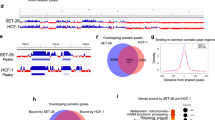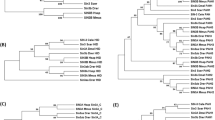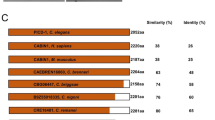Abstract
DAF-16, a forkhead transcription factor, is a key regulator of longevity, metabolism and dauer diapause in Caenorhabditis elegans. The precise mechanism by which DAF-16 regulates multiple functions, however, is poorly understood. Here, we used chromatin immunoprecipitation (ChIP) to identify direct _targets of DAF-16. We cloned 103 _target sequences containing consensus DAF-16 binding sites and selected 33 _targets for further analysis. Expression of most of these genes is regulated in a DAF-16–dependent manner, and inactivation of more than half of these genes significantly altered DAF-16–dependent functions, including life span, fat storage and dauer formation. Our results show that the ChIP-based cloning strategy leads to greater enrichment for DAF-16 _target genes than previous screening strategies. We also demonstrate that DAF-16 is recruited to multiple promoters to coordinate regulation of its downstream _targets. The large number of _target genes discovered provides insight into how DAF-16 controls diverse biological functions.
This is a preview of subscription content, access via your institution
Access options
Subscribe to this journal
Receive 12 print issues and online access
We are sorry, but there is no personal subscription option available for your country.
Buy this article
- Purchase on SpringerLink
- Instant access to full article PDF
Prices may be subject to local taxes which are calculated during checkout



Similar content being viewed by others
References
Barbieri, M., Bonafe, M., Franceschi, C. & Paolisso, G. Insulin/IGF-I-signaling pathway: an evolutionarily conserved mechanism of longevity from yeast to humans. Am. J. Physiol. Endocrinol. Metab. 285, E1064–E1071 (2003).
Kenyon, C. The plasticity of aging: insights from long-lived mutants. Cell 120, 449–460 (2005).
Oh, S.W. et al. JNK regulates lifespan in Caenorhabditis elegans by modulating nuclear translocation of forkhead transcription factor/DAF-16. Proc. Natl. Acad. Sci. USA 102, 4494–4499 (2005).
Murphy, C.T. et al. Genes that act downstream of DAF-16 to influence the lifespan of Caenorhabditis elegans. Nature 424, 277–283 (2003).
McElwee, J., Bubb, K. & Thomas, J.H. Transcriptional outputs of the Caenorhabditis elegans forkhead protein DAF-16. Aging Cell 2, 111–121 (2003).
Lee, S.S., Kennedy, S., Tolonen, A.C. & Ruvkun, G. DAF-16 _target genes that control C. elegans life-span and metabolism. Science 300, 644–647 (2003).
Weinmann, A.S. Novel ChIP-based strategies to uncover transcription factor _target genes in the immune system. Nat. Rev. Immunol. 4, 381–386 (2004).
Raha, T., Cheng, S.W. & Green, M.R. HIV-1 Tat stimulates transcription complex assembly through recruitment of TBP in the absence of TAFs. PLoS Biol. 3, e44 (2005).
Furuyama, T., Nakazawa, T., Nakano, I. & Mori, N. Identification of the differential distribution patterns of mRNAs and consensus binding sequences for mouse DAF-16 homologues. Biochem. J. 349, 629–634 (2000).
Honda, Y. & Honda, S. The daf-2 gene network for longevity regulates oxidative stress resistance and Mn-superoxide dismutase gene expression in Caenorhabditis elegans. FASEB J. 13, 1385–1393 (1999).
Lin, K., Dorman, J.B., Rodan, A. & Kenyon, C. daf-16: An HNF-3/forkhead family member that can function to double the life-span of Caenorhabditis elegans. Science 278, 1319–1322 (1997).
Libina, N., Berman, J.R. & Kenyon, C. Tissue-specific activities of C. elegans DAF-16 in the regulation of lifespan. Cell 115, 489–502 (2003).
Kimura, K.D., Tissenbaum, H.A., Liu, Y. & Ruvkun, G. daf-2, an insulin receptor-like gene that regulates longevity and diapause in Caenorhabditis elegans. Science 277, 942–946 (1997).
Lin, K., Hsin, H., Libina, N. & Kenyon, C. Regulation of the Caenorhabditis elegans longevity protein DAF-16 by insulin/IGF-1 and germline signaling. Nat. Genet. 28, 139–145 (2001).
Lee, R.Y., Hench, J. & Ruvkun, G. Regulation of C. elegans DAF-16 and its human ortholog FKHRL1 by the daf-2 insulin-like signaling pathway. Curr. Biol. 11, 1950–1957 (2001).
Henderson, S.T. & Johnson, T.E. daf-16 integrates developmental and environmental inputs to mediate aging in the nematode Caenorhabditis elegans. Curr. Biol. 11, 1975–1980 (2001).
De Belle, I., Wu, J.X., Sperandio, S., Mercola, D. & Adamson, E.D. In vivo cloning and characterization of a new growth suppressor protein TOE1 as a direct _target gene of Egr1. J. Biol. Chem. 278, 14306–14312 (2003).
Yanase, S., Yasuda, K. & Ishii, N. Adaptive responses to oxidative damage in three mutants of Caenorhabditis elegans (age-1, mev-1 and daf-16) that affect life span. Mech. Ageing Dev. 123, 1579–1587 (2002).
Kops, G.J. et al. Forkhead transcription factor FOXO3a protects quiescent cells from oxidative stress. Nature 419, 316–321 (2002).
Turner, A.J., Isaac, R.E. & Coates, D. The neprilysin (NEP) family of zinc metalloendopeptidases: genomics and function. Bioessays 23, 261–269 (2001).
Kadowaki, T. & Yamauchi, T. Adiponectin and adiponectin receptors. Endocr. Rev. 26, 439–451 (2005).
Oka, T., Yamamoto, R. & Futai, M. Multiple genes for vacuolar-type ATPase proteolipids in Caenorhabditis elegans. A new gene, vha-3, has a distinct cell-specific distribution. J. Biol. Chem. 273, 22570–22576 (1998).
Ashrafi, K. et al. Genome-wide RNAi analysis of Caenorhabditis elegans fat regulatory genes. Nature 421, 268–272 (2003).
Gottlieb, S. & Ruvkun, G. daf-2, daf-16, and daf-23: Genetically interacting genes controlling dauer formation in C. elegans. Genetics 137, 107–120 (1994).
Ogg, S. et al. The Fork head transcription factor DAF-16 transduces insulin-like metabolic and longevity signals in C. elegans. Nature 389, 994–999 (1997).
Malone, E.A. & Thomas, J.H. A screen for non-conditional dauer-constitutive mutations in C. elegans. Genetics 136, 879–886 (1994).
Hamilton, B. et al. A systematic RNAi screen for longevity genes in C. elegans. Genes Dev. 19, 1544–1555 (2005).
Conte, D. & Mello, C.C. RNA interference. in Current Protocols in Molecular Biology (eds. Ausubel, F.M. et al.) (Wiley, Hoboken, New Jersey, 2003).
Hosono, R., Mitsui, Y., Sato, Y., Aizawa, S. & Miwa, J. Life span of the wild and mutant nematode Caenorhabditis elegans. Effects of sex, sterilization, and temperature. Exp. Gerontol. 17, 163–172 (1982).
Mukhopadhyay, A., Deplancke, B., Walhout, A.J. & Tissenbaum, H.A. C. elegans tubby regulates life span and fat storage by two independent mechanisms. Cell Metab. 2, 35–42 (2005).
Acknowledgements
We would like to thank M. Walhout, C. Mello, R. Davis, T. Duchaine, L. Maduira and M. Czech for their help and insights and members of the Tissenbaum lab and S. Evans for critical reading of the manuscript. Some of the strains were kindly provided by T. Stiernagle at the Caenorhabditis Genetics Center, which is funded by the US National Institutes of Health National Center for Research Resources. H.A.T. is a William Randolph Hearst Young Investigator. This project was funded in part by a Burroughs Wellcome Career Award in the Biomedical Sciences to H.A.T. and an endowment from the William Randolph Hearst Foundation and Worcester Foundation Scholar Award to H.A.T.
Author information
Authors and Affiliations
Corresponding author
Ethics declarations
Competing interests
The authors declare no competing financial interests.
Supplementary information
Supplementary Table 1
A list of 103 _target genes identified by ChIP cloning. (PDF 35 kb)
Supplementary Table 2
A list of DAF-16 downstream _target genes identified by ChIP cloning in common with previous studies. (PDF 12 kb)
Rights and permissions
About this article
Cite this article
Wook Oh, S., Mukhopadhyay, A., Dixit, B. et al. Identification of direct DAF-16 _targets controlling longevity, metabolism and diapause by chromatin immunoprecipitation. Nat Genet 38, 251–257 (2006). https://doi.org/10.1038/ng1723
Received:
Accepted:
Published:
Issue Date:
DOI: https://doi.org/10.1038/ng1723



